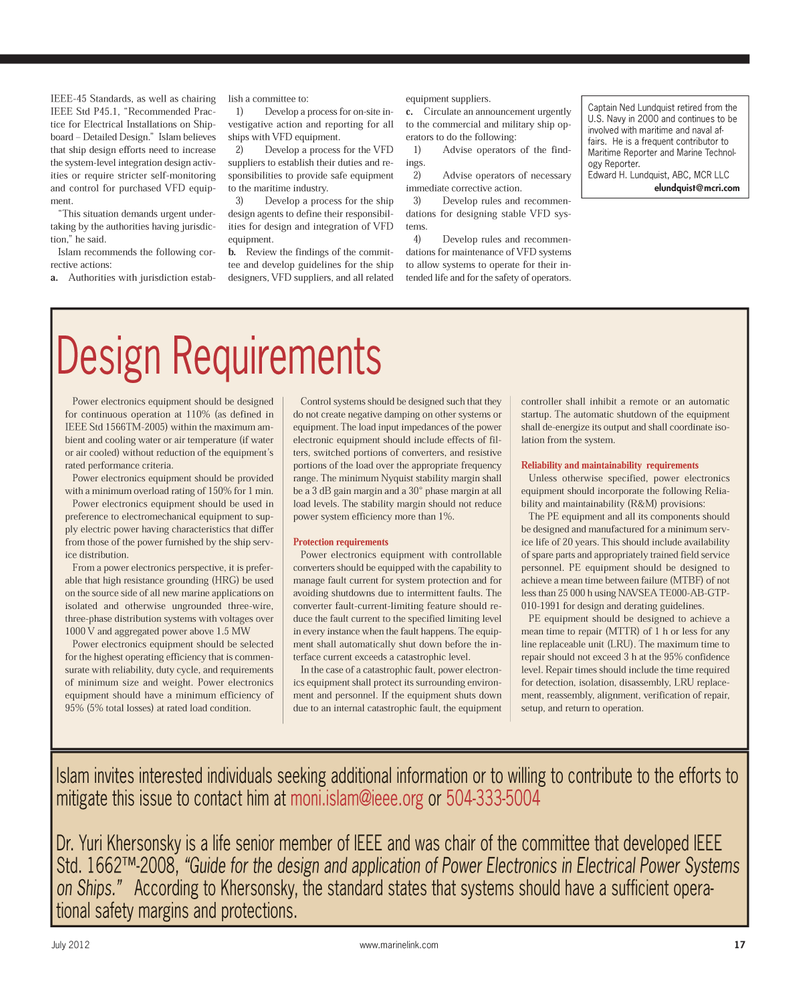
Page 17: of Maritime Reporter Magazine (July 2012)
Arctic Operations
Read this page in Pdf, Flash or Html5 edition of July 2012 Maritime Reporter Magazine
July 2012www.marinelink.com 17IEEE-45 Standards, as well as chairingIEEE Std P45.1, ?Recommended Prac-tice for Electrical Installations on Ship-board ? Detailed Design.? Islam believes that ship design efforts need to increase the system-level integration design activ- ities or require stricter self-monitoringand control for purchased VFD equip- ment.?This situation demands urgent under- taking by the authorities having jurisdic- tion,? he said. Islam recommends the following cor- rective actions: a.Authorities with jurisdiction estab-lish a committee to:1)Develop a process for on-site in- vestigative action and reporting for all ships with VFD equipment. 2)Develop a process for the VFD suppliers to establish their duties and re-sponsibilities to provide safe equipment to the maritime industry. 3)Develop a process for the ship design agents to define their responsibil- ities for design and integration of VFD equipment.b.Review the findings of the commit- tee and develop guidelines for the ship designers, VFD suppliers, and all related equipment suppliers.c.Circulate an announcement urgently to the commercial and military ship op-erators to do the following: 1)Advise operators of the find- ings.2)Advise operators of necessary immediate corrective action. 3)Develop rules and recommen- dations for designing stable VFD sys- tems.4)Develop rules and recommen- dations for maintenance of VFD systems to allow systems to operate for their in- tended life and for the safety of operators.Captain Ned Lundquist retired from the U.S. Navy in 2000 and continues to beinvolved with maritime and naval af-fairs. He is a frequent contributor to Maritime Reporter and Marine Technol- ogy Reporter. Edward H. Lundquist, ABC, MCR LLC [email protected] Requirements Power electronics equipment should be designed for continuous operation at 110% (as defined in IEEE Std 1566TM-2005) within the maximum am-bient and cooling water or air temperature (if water or air cooled) without reduction of the equipment?s rated performance criteria. Power electronics equipment should be provided with a minimum overload rating of 150% for 1 min. Power electronics equipment should be used in preference to electromechanical equipment to sup-ply electric power having characteristics that differ from those of the power furnished by the ship serv- ice distribution. From a power electronics perspective, it is prefer- able that high resistance grounding (HRG) be usedon the source side of all new marine applications on isolated and otherwise ungrounded three-wire,three-phase distribution systems with voltages over 1000 V and aggregated power above 1.5 MW Power electronics equipment should be selected for the highest operating efficiency that is commen- surate with reliability, duty cycle, and requirements of minimum size and weight. Power electronics equipment should have a minimum efficiency of 95% (5% total losses) at rated load condition.Control systems should be designed such that they do not create negative damping on other systems or equipment. The load input impedances of the power electronic equipment should include effects of fil- ters, switched portions of converters, and resistive portions of the load over the appropriate frequency range. The minimum Nyquist stability margin shall be a 3 dB gain margin and a 30° phase margin at all load levels. The stability margin should not reduce power system efficiency more than 1%. Protection requirements Power electronics equipment with controllable converters should be equipped with the capability to manage fault current for system protection and for avoiding shutdowns due to intermittent faults. The converter fault-current-limiting feature should re- duce the fault current to the specified limiting level in every instance when the fault happens. The equip- ment shall automatically shut down before the in- terface current exceeds a catastrophic level. In the case of a catastrophic fault, power electron- ics equipment shall protect its surrounding environ- ment and personnel. If the equipment shuts down due to an internal catastrophic fault, the equipment controller shall inhibit a remote or an automaticstartup. The automatic shutdown of the equipment shall de-energize its output and shall coordinate iso- lation from the system.Reliability and maintainability requirements Unless otherwise specified, power electronics equipment should incorporate the following Relia- bility and maintainability (R&M) provisions: The PE equipment and all its components shouldbe designed and manufactured for a minimum serv- ice life of 20 years. This should include availability of spare parts and appropriately trained field service personnel. PE equipment should be designed toachieve a mean time between failure (MTBF) of not less than 25 000 h using NAVSEA TE000-AB-GTP- 010-1991 for design and derating guidelines.PE equipment should be designed to achieve a mean time to repair (MTTR) of 1 h or less for any line replaceable unit (LRU). The maximum time to repair should not exceed 3 h at the 95% confidence level. Repair times should include the time required for detection, isolation, disassembly, LRU replace- ment, reassembly, alignment, verification of repair, setup, and return to operation. Islam invites interested individuals seeking additional information or to willing to contribute to the efforts to mitigate this issue to contact him at [email protected] or504-333-5004Dr. Yuri Khersonsky is a life senior member of IEEE and was chair of the committee that developed IEEE Std. 1662?-2008, ?Guide for the design and application of Power Electronics in Electrical Power Systems on Ships.?According to Khersonsky, the standard states that systems should have a sufficient opera- tional safety margins and protections. MR#7 (10-17):MR Template 7/6/2012 10:04 AM Page 17

 16
16

 18
18
